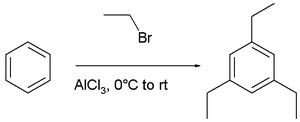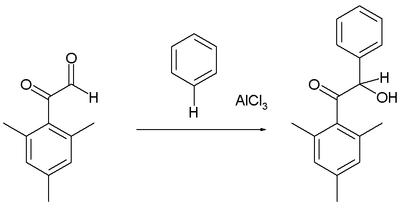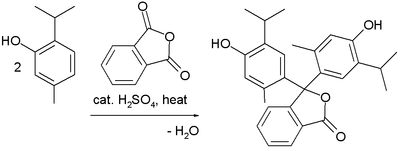The Friedel–Crafts reactions are a set of reactions developed by Charles Friedel and James Crafts in 1877 to attach substituents to an aromatic ring. Friedel–Crafts reactions are of two main types: alkylation reactions and acylation reactions. Both proceed by electrophilic aromatic substitution.
Friedel–Crafts alkylation
Friedel–Crafts alkylation involves the alkylation of an aromatic ring with an alkyl halide using a strong Lewis acid catalyst.[6] With anhydrous ferric chloride as a catalyst, the alkyl group attaches at the former site of the chloride ion. The general mechanism is shown below.[7]This reaction suffers from the disadvantage that the product is more nucleophilic than the reactant. Consequenly, overalkylation occurs. Furthermore, the reaction is only very useful for tertiary carbon and secondary alkylating agents. Otherwise the incipient carbocation (R+) will undergo a carbocation rearrangement reaction.[7]
Steric hindrance can be exploited to limit the number of alkylations, as in the t-butylation of 1,4-dimethoxybenzene.[citation needed]
Alkylations are not limited to alkyl halides: Friedel–Crafts reactions are possible with any carbocationic intermediate such as those derived from alkenes and a protic acid, Lewis acid, enones, and epoxides. An example is the synthesis of neophyl chloride from benzene and methallyl chloride:[8]
- H2C=C(CH3)CH2Cl + C6H6 → C6H5C(CH3)2CH2Cl
In this reaction samarium(III) triflate is believed to activate the NBS halogen donor in halonium ion formation.
Friedel–Crafts dealkylation
Friedel–Crafts alkylation has been hypothesized to be reversible. In a reversed Friedel–Crafts reaction or Friedel–Crafts dealkylation, alkyl groups are removed in the presence of protons or other Lewis acid.For example, in a multiple addition of ethyl bromide to benzene, ortho and para substitution is expected after the first monosubstitution step because an alkyl group is an activating group. However, the actual reaction product is 1,3,5-triethylbenzene with all alkyl groups as a meta substituent.[10] Thermodynamic reaction control makes sure that thermodynamically favored meta substitution with steric hindrance minimized takes prevalence over less favorable ortho and para substitution by chemical equilibration. The ultimate reaction product is thus the result of a series of alkylations and dealkylations.[citation needed]
Friedel–Crafts acylation
Friedel–Crafts acylation involves the acylation of aromatic rings. Typical acylating agents are acyl chlorides. Typical Lewis acid catalysts are acids and aluminium trichloride. Friedel–Crafts acylation is also possible with acid anhydrides.[11] Reaction conditions are similar to the Friedel–Crafts alkylation. This reaction has several advantages over the alkylation reaction. Due to the electron-withdrawing effect of the carbonyl group, the ketone product is always less reactive than the original molecule, so multiple acylations do not occur. Also, there are no carbocation rearrangements, as the carbonium ion is stabilized by a resonance structure in which the positive charge is on the oxygen.The viability of the Friedel–Crafts acylation depends on the stability of the acyl chloride reagent. Formyl chloride, for example, is too unstable to be isolated. Thus, synthesis of benzaldehyde via the Friedel–Crafts pathway requires that formyl chloride be synthesized in situ. This is accomplished via the Gattermann-Koch reaction, accomplished by treating benzene with carbon monoxide and hydrogen chloride under high pressure, catalyzed by a mixture of aluminium chloride and cuprous chloride.
Reaction mechanism
The reaction proceeds via generation of an acylium center:The reaction is completed by deprotonation of the arenium ion by AlCl4−, regenerating the AlCl3 catalyst:
If desired, the resulting ketone can be subsequently reduced to the corresponding alkane substituent by either Wolff–Kishner reduction or Clemmensen reduction. The net result is the same as the Friedel–Crafts alkylation except that rearrangement is not possible.[12]
Friedel–Crafts hydroxyalkylation
Arenes react with certain aldehydes and ketones to form the hydroxyalkylated products, for example in the reaction of the mesityl derivative of glyoxal with benzene:[13]As usual, the aldehyde group is more reactive electrophile than the phenone.
Friedel–Crafts sulfonylation
Under Friedel–Crafts reaction conditions, arenes react with sulfonyl halides and sulfonic acid anhydrides affording sulfones. Commonly used catalysts include AlCl3, FeCl3, GaCl3, BF3, SbCl5, BiCl3 and Bi(OTf)3, among others.[14][15] Intramolecular Friedel–Crafts cyclization occurs with 2-phenyl-1-ethanesulfonyl chloride, 3-phenyl-1-propanesulfonyl chloride and 4-phenyl-1-butanesulfonyl chloride on heating in nitrobenzene with AlCl3.[16] Sulfenyl and sulfinyl chlorides also undergo Friedel–Crafts–type reactions, affording sulfides and sulfoxides, respectively.[17] Both aryl sulfinyl chlorides and diaryl sulfoxides can be prepared from arenes through reaction with thionyl chloride in the presence of catalysts such as BiCl3, Bi(OTf)3, LiClO4 or NaClO4.[18][19]Scope and variations
This reaction is related to several classic named reactions:- The acylated reaction product can be converted into the alkylated product via a Clemmensen reduction.[20][21][22]
- The Gattermann–Koch reaction can be used to synthesize benzaldehyde from benzene.[23]
- The Gatterman reaction describes arene reactions with hydrocyanic acid.[24]
- The Houben–Hoesch reaction describes arene reactions with nitriles.[25][26]
- A reaction modification with an aromatic phenyl ester as a reactant is called the Fries rearrangement.
- In the Scholl reaction two arenes couple directly (sometimes called Friedel–Crafts arylation).[27][28]
- In the Zincke–Suhl reaction p-cresol is alkylated to a cyclohexadienone with tetrachloromethane.[29]
- In the Blanc chloromethylation a chloromethyl group is added to an arene with formaldehyde, hydrochloric acid and zinc chloride.[30][31]
- The Bogert–Cook synthesis (1933) involves the dehydration and isomerization of 1-β-phenylethylcyclohexanol to the octahydro derivative of phenanthrene[32]

- The Darzens–Nenitzescu synthesis of ketones (1910, 1936) involves the acylation of cyclohexene with acetyl chloride to methylcyclohexenylketone.
- In the related Nenitzescu reductive acylation (1936) a saturated hydrocarbon is added making it a reductive acylation to methylcyclohexylketone
- The Nencki reaction (1881) is the ring acetylation of phenols with acids in the presence of zinc chloride.[33]
- In a green chemistry variation aluminium chloride is replaced by graphite in an alkylation of p-xylene with 2-bromobutane. This variation will not work with primary halides from which less carbocation involvement is inferred.[34]
Dyes
Friedel–Crafts reactions have been used in the synthesis of several triarylmethane and xanthene dyes.[35] Examples are the synthesis of thymolphthalein (a pH indicator) from two equivalents of thymol and phthalic anhydride:A reaction of phthalic anhydride with resorcinol in the presence of zinc chloride gives the fluorophore Fluorescein. Replacing resorcinol by N,N-diethylaminophenol in this reaction gives rhodamine B:
Haworth reactions
The Haworth reaction is a classic method for the synthesis of 1-tetralone.[36] In it benzene is reacted with succinic anhydride, the intermediate product is reduced and a second FC acylation takes place with addition of acid.[37]In a related reaction, phenanthrene is synthesized from naphthalene and succinic anhydride in a series of steps.












